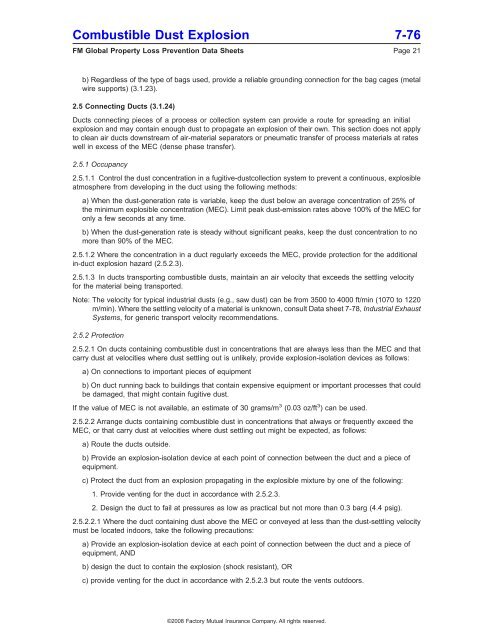DS 7-76 Prevention and Mitigation of Combustible Dust ... - FM Global
DS 7-76 Prevention and Mitigation of Combustible Dust ... - FM Global
DS 7-76 Prevention and Mitigation of Combustible Dust ... - FM Global
You also want an ePaper? Increase the reach of your titles
YUMPU automatically turns print PDFs into web optimized ePapers that Google loves.
<strong>Combustible</strong> <strong>Dust</strong> Explosion 7-<strong>76</strong><br />
<strong>FM</strong> <strong>Global</strong> Property Loss <strong>Prevention</strong> Data Sheets Page 21<br />
b) Regardless <strong>of</strong> the type <strong>of</strong> bags used, provide a reliable grounding connection for the bag cages (metal<br />
wire supports) (3.1.23).<br />
2.5 Connecting Ducts (3.1.24)<br />
Ducts connecting pieces <strong>of</strong> a process or collection system can provide a route for spreading an initial<br />
explosion <strong>and</strong> may contain enough dust to propagate an explosion <strong>of</strong> their own. This section does not apply<br />
to clean air ducts downstream <strong>of</strong> air-material separators or pneumatic transfer <strong>of</strong> process materials at rates<br />
well in excess <strong>of</strong> the MEC (dense phase transfer).<br />
2.5.1 Occupancy<br />
2.5.1.1 Control the dust concentration in a fugitive-dustcollection system to prevent a continuous, explosible<br />
atmosphere from developing in the duct using the following methods:<br />
a) When the dust-generation rate is variable, keep the dust below an average concentration <strong>of</strong> 25% <strong>of</strong><br />
the minimum explosible concentration (MEC). Limit peak dust-emission rates above 100% <strong>of</strong> the MEC for<br />
only a few seconds at any time.<br />
b) When the dust-generation rate is steady without significant peaks, keep the dust concentration to no<br />
more than 90% <strong>of</strong> the MEC.<br />
2.5.1.2 Where the concentration in a duct regularly exceeds the MEC, provide protection for the additional<br />
in-duct explosion hazard (2.5.2.3).<br />
2.5.1.3 In ducts transporting combustible dusts, maintain an air velocity that exceeds the settling velocity<br />
for the material being transported.<br />
Note: The velocity for typical industrial dusts (e.g., saw dust) can be from 3500 to 4000 ft/min (1070 to 1220<br />
m/min). Where the settling velocity <strong>of</strong> a material is unknown, consult Data sheet 7-78, Industrial Exhaust<br />
Systems, for generic transport velocity recommendations.<br />
2.5.2 Protection<br />
2.5.2.1 On ducts containing combustible dust in concentrations that are always less than the MEC <strong>and</strong> that<br />
carry dust at velocities where dust settling out is unlikely, provide explosion-isolation devices as follows:<br />
a) On connections to important pieces <strong>of</strong> equipment<br />
b) On duct running back to buildings that contain expensive equipment or important processes that could<br />
be damaged, that might contain fugitive dust.<br />
If the value <strong>of</strong> MEC is not available, an estimate <strong>of</strong> 30 grams/m 3 (0.03 oz/ft 3 ) can be used.<br />
2.5.2.2 Arrange ducts containing combustible dust in concentrations that always or frequently exceed the<br />
MEC, or that carry dust at velocities where dust settling out might be expected, as follows:<br />
a) Route the ducts outside.<br />
b) Provide an explosion-isolation device at each point <strong>of</strong> connection between the duct <strong>and</strong> a piece <strong>of</strong><br />
equipment.<br />
c) Protect the duct from an explosion propagating in the explosible mixture by one <strong>of</strong> the following:<br />
1. Provide venting for the duct in accordance with 2.5.2.3.<br />
2. Design the duct to fail at pressures as low as practical but not more than 0.3 barg (4.4 psig).<br />
2.5.2.2.1 Where the duct containing dust above the MEC or conveyed at less than the dust-settling velocity<br />
must be located indoors, take the following precautions:<br />
a) Provide an explosion-isolation device at each point <strong>of</strong> connection between the duct <strong>and</strong> a piece <strong>of</strong><br />
equipment, AND<br />
b) design the duct to contain the explosion (shock resistant), OR<br />
c) provide venting for the duct in accordance with 2.5.2.3 but route the vents outdoors.<br />
©2008 Factory Mutual Insurance Company. All rights reserved.

















